An art museum, a large vessel storing and displaying works of art, becomes an artwork in itself when it is designed by a world-renowned architect. When the architecture is in harmony with the surroundings and true to the nature of the museum’s collection, it becomes a medium for the message the museum seeks to deliver.
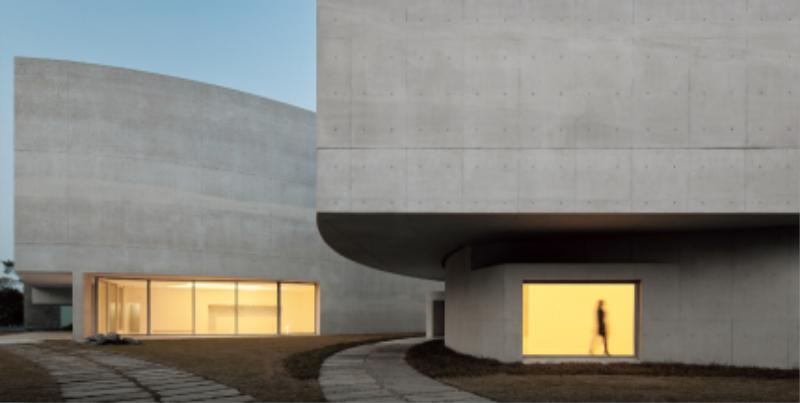
Mimesis Art Museum, built in 2009 in Paju Book City, was designed by Portuguese architect Álvaro Siza. Featuring curved surfaces, the exhibition space allows in as much natural sunlight as possible to show the play of light at different times of the day.
Courtesy of Openbooks, Photo by Fernando Guerra
If visiting a museum is a trip to the past, going to an art museum is a journey through the present. While museums generally display ancient objects and traces of past human lives and culture, art museums exhibit works that are comparably new. A museum can house anything and everything, including but not limited to cultural heritage, and in that sense, an art museum, which specializes in collecting and displaying works of art, is a type of museum.
The two are similar but subtly different in identity, and their architecture tends to differ accordingly. Like the Louvre in Paris, many museums are housed in renovated historical buildings. However, more often than not, art museums are built for their specific purpose and function, like the Solomon R. Guggenheim Museum in New York, designed by Frank Llyod Wright, and the Guggenheim Museum Bilbao in the Basque Country, Spain, designed by Frank Gehry. Such art museums created by renowned architects are important tourist attractions in their own right. Korea has a rich history and culture of over five thousand years, and its cities strike a delicate balance between tradition and modernity. Making up part of this assemblage of old and new are numerous art museums and galleries, some the work of world-famous architects and consequently stunning works of art themselves.
Scale and Class of National Museums
The National Museum of Modern and Contemporary Art (MMCA) boasts a vast collection. The head museum is located in Gwacheon, Gyeonggi Province, close to the metropolitan area, and two branches are located in Seoul, and another in Cheongju, North Chungcheong Province, 130 kilometers from the capital.
One of the Seoul branches of the MMCA is found inside Deoksu Palace, where Joseon monarchs resided. Seokjojeon, literally meaning “hall made of stone,” is a Neoclassical structure designed by British architect John Reginald Harding. Completed in 1910, it was meant to be the king’s living quarters, but in 1933, during the Japanese occupation, it was turned into a public art museum. A survivor through the vicissitudes of history, Seokjojeon has housed the Daehan Empire History Museum since 2014. The western wing of the building, designed by a Japanese architect and constructed in 1938, currently serves as a branch of the MMCA. The home of the Yi Royal Family Museum when it opened, it remains today as Korea’s first purpose-built museum.
The MMCA Seoul, a relatively new place opened in 2013, is located in the center of the city. Designed by Mihn Hyun-jun, an architecture professor at Hongik University, it sits across the road from Gyeongbok Palace, the main palace of Joseon. With many historical sites in the area, building height restrictions apply in this part of the city; as a result, the museum is not a tall building and instead features an underground exhibition area. While the exterior is understated, the interior is state-of-the-art. There are galleries of different sizes and functions, as well as an event hall (Multi-project Hall), a movie theater and art shops. On the walls are the works of Korean and foreign artists active on the contemporary scene.
An hour on the subway from downtown Seoul will bring you to the MMCA Gwacheon, Nestled in beautiful forestland and famous for its lobby centerpiece – “The More, The Better” (1986-1988) by the father of media art, Nam June Paik. The lush grounds feature an outdoor sculpture park, and the museum attracts a lot of families because of the nearby zoo and amusement park. Lastly, the MMCA Cheongju stores and manages all the MMCA collections. Housed in a renovated factory where cigarettes were once made, the museum operates a huge open storage that invites visitors to look at the collections in their stored state.
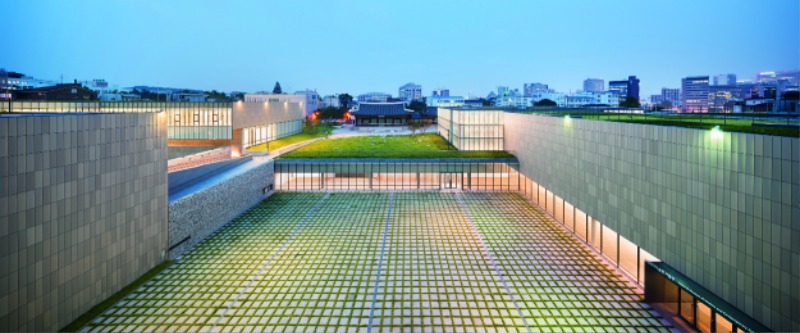
The National Museum of Modern and Contemporary Art Seoul, opened in 2013, was designed by Mihn Hyun-Jun. The building is low to allow views of the surrounding area and feels open and spacious with its several courtyards. At the back are parts of the building used by the Office of Royal Genealogy during the Joseon Dynasty.
Courtesy of the National Museum of Modern and Contemporary Art, Photo by Namgoong Sun
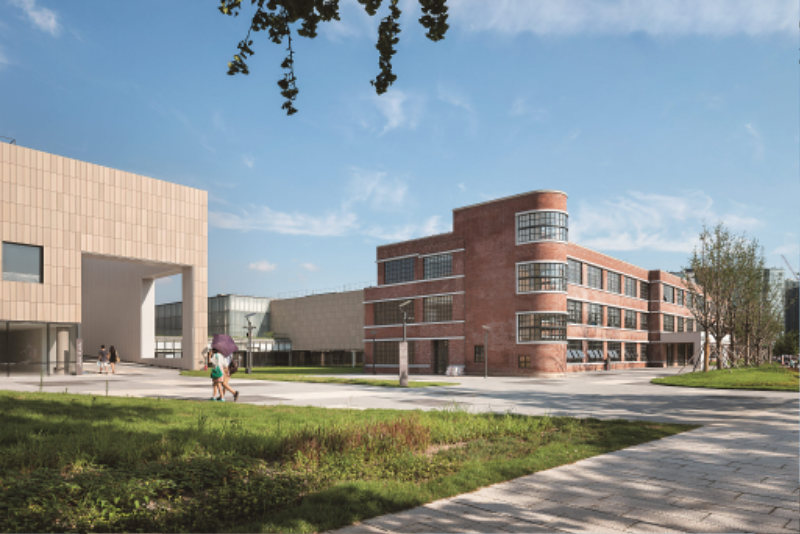
The former Defense Security Command building, now serving as the entrance to the National Museum of Modern and Contemporary Art Seoul. First built in 1932, it was once used as an outpatient clinic of the Gyeongseong Medical College and an annex of the Defense Security Command from 1971 to 2008.
Courtesy of the National Museum of Modern and Contemporary Art, Photo by Myung Yi-shick
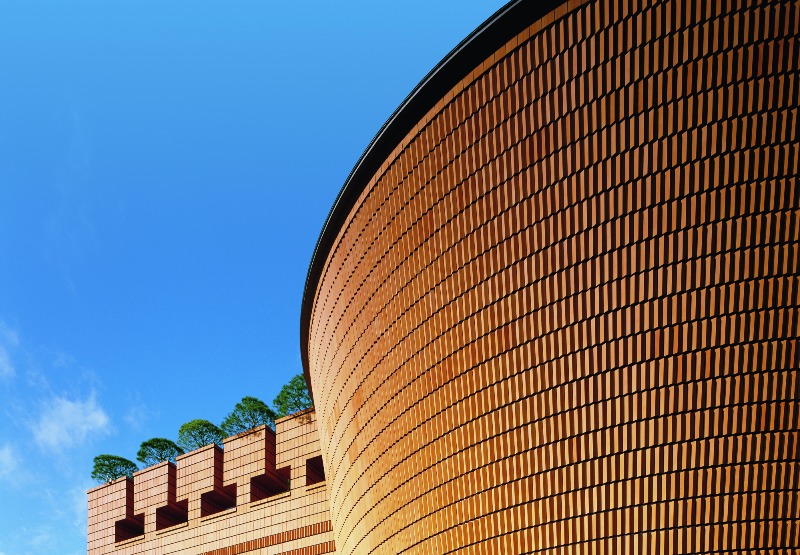
The Leeum Museum of Art comprises three buildings designed by world-renowned architects Mario Botta, Jean Nouvel, and Rem Koolhaas, respectively. M1 showcases the traditional Korean art collection. It was designed by Mario Botta, who was inspired by the beauty of Korean ceramics.
Courtesy of Leeum Museum of Art, Photo by Lee Han-koo
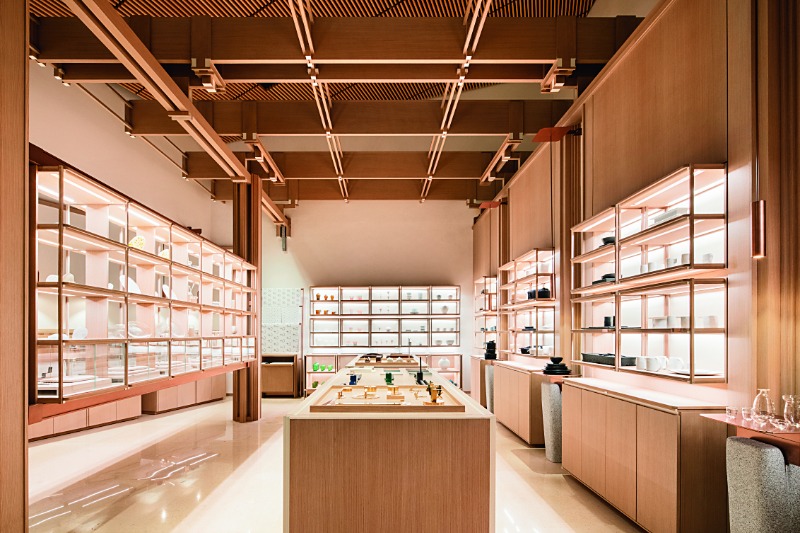
The Leeum Museum of Art reopened in 2021 after several years of renovation. The Leeum Store, located in the lobby, was turned into specialty shop for the works of Korean craftsmen.
ⓒ Leeum Museum of Art
Architectural Highlights
Leeum Museum of Art, opened in 2004, is Korea’s most prominent private art museum. Located in Hannam-dong, Seoul, it is a hybrid of a regular museum and an art museum, in that it displays both national treasure-grade cultural artifacts and sophisticated contemporary artworks.
It prides itself not only on having one of the finest collections in the country but also on being housed in an outstanding architectural space. The museum comprises three buildings, each designed by a different world-renowned architect. All the buildings have unique identities and represent quintessential works of art museum architecture. Some compare the Leeum to a bowl of bibimbap, a popular Korean rice dish with a mixture of differently flavored ingredients, as the museum’s buildings all have different characters but present a beautiful composition.
M1, showcasing the Leeum’s collection of traditional Korean art, is the work of Mario Botta, a Swiss-born architect who also designed the San Francisco Museum of Modern Art. M2 is a black-grey steel structure housing the museum’s modern and contemporary art collection. It was designed by French architect Jean Nouvel, whose notable projects include the Arab World Institute in Paris and the National Museum of Qatar in Doha. Lastly, the Blackbox is a futuristicblack concrete and glass edifice that serves as a special exhibition hall. It was designed by Dutch architect Rem Koolhaas, one of the most famous and influential architects in the world with works in many major cities, including the CCTV Headquarters in Beijing, the Seattle Central Library in Washington, and the Seoul National University Museum of Art in Korea.
Seoul is home to many other great works of modern architecture, one being Dongdaemun Design Plaza. Commonly known as the DDP, it has become a landmark of Seoul that beckons to architecture students from around the world. Designed by the late Iraq-born architect Zaha Hadid, who passed away in 2016, it has a striking exterior finished in soft curves, with not a single straight line. A free-form building resembling a spacecraft, it does not have an identifiable façade, nor does it give away how many stories it has. Its low, wide-spreading forms are in stark contrast with the high-rises in the vicinity. Though it often hosts exhibitions, the DDP is not a museum per se but a cultural complex that hosts diverse events such as fashion shows.
To the northwest of Seoul is the publishing hub Paju Book City. The Mimesis Art Museum, designed by Portuguese architect Álvaro Siza, sits in the center, drawing attention to itself with its white exterior finished in soft, curving lines. Befitting an art museum operated by an art book publisher, the Mimesis has exhibition areas of different sizes, and a bookstore on the first floor.
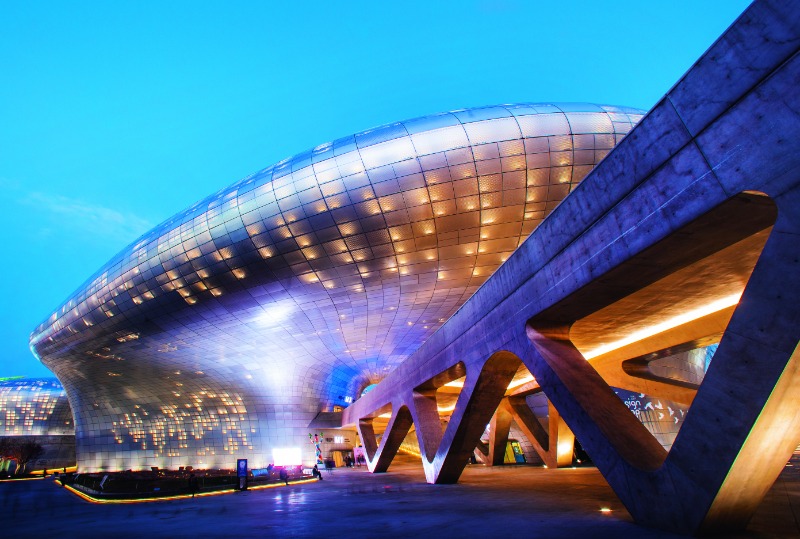
Dongdaemun Design Plaza, designed by Iraqborn architect Zaha Hadid, is now a famous landmark that attracts architecture students from around the world. It is a cultural complex hosting various events such as fashion shows and design and art exhibitions.
ⓒ TongRo Images
Art Museums with a View
Museum SAN is situated inside the Oak Valley Resort in Wonju, Gangwon Province. Designed by Japanese architect Tadao Ando, it opened in May 2013. The art museum is famous for its grandscale installations by the artist James Turrell, known as the “artist of light and space,” with the exhibition space extending two kilometers in length. In 2014, the Financial Times introduced the museum with the architect’s quote, “[I wanted to create] a garden museum in the sky, a dreamlike museum like no other.” In 2016, The Artling, a Singaporean art magazine, featured Museum SAN in an article titled “Four Destination Museums in Asia You Must Visit Before You Die.” Perched on a mountain top, Museum SAN fits snugly in the surrounding environment. A 700-meter long alley leads from the entrance up to the James Turrell building. The museum allows visitors to simultaneously appreciate the beauty of contemporary art and contemporary architecture.
The Memorial Hall of the House of Goam Lee Ungno, one of numerous museums built in commemoration of celebrated Korean artists, was built in 2011 in the village of Hongseong in South Chungcheong Province, where Lee was born and raised. Lee Ungno (1904-1989) painted in the traditional Korean art style and comfortably settled into the life of an art professor at a young age. Then, at the age of 50, he suddenly left his stellar career behind and moved to France where he knew no one. There, he refined his personal style of mixing Eastern and Western art, successfully attracting the attention of the European art scene with his “Abstract Letter” and “Crowd” series.
Designed by veteran Korean architect Joh Sung-yong, the Memorial Hall is a small and modest structure encouraging people and nature to mingle, just like Lee’s artworks do. Not only is the building beautiful but also the landscaping of the front yard that includes a lotus pond. The place dazzles visitors with a perfect harmony of art and nature, which is not as easily found at large-scale museums. Joh’s most important projects include the Uijae Museum of Korean Art in Gwangju, the Seoul Olympic Museum of Art inside Seoul’s Olympic Park, and Seonyudo Park on the eponymous island on the Han River, which flows through the capital. The Uijae Museum of Korean Art was built in 2001 at the foot of Mt. Mudeung in Gwangju to commemorate the artistic spirit and achievements of Heo Baek-ryeon (1891-1977). Heo carried on the techniques and spirit of traditional painting, unlike most of his contemporaries who lived in Seoul and pursued a modern style. In addition to being a painter, he set up an agricultural technology school and cultivated tea fields. By working with the geographical
constraintspresented by the Mt. Mudeung hiking trail, the museum nestles into the site, presenting a view that has been likened to an ink painting itself. In 2013, Mt. Mudeung came under state protection, making the museum Korea’s only private art museum located in a national park.
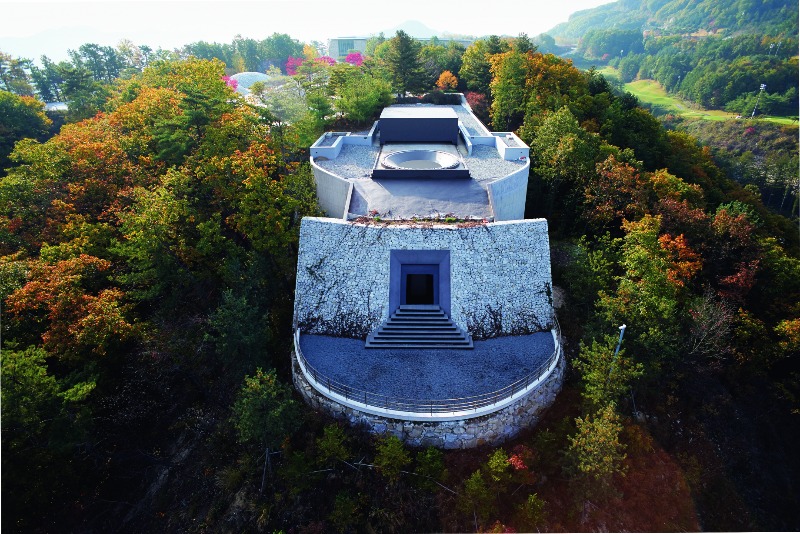
The James Turrell Exhibition Hall at Museum SAN. Situated deep in the mountains of Wonju, Gangwon Province, this museum designed by Tadao Ando opened in May 2013.
ⓒMuseum SAN
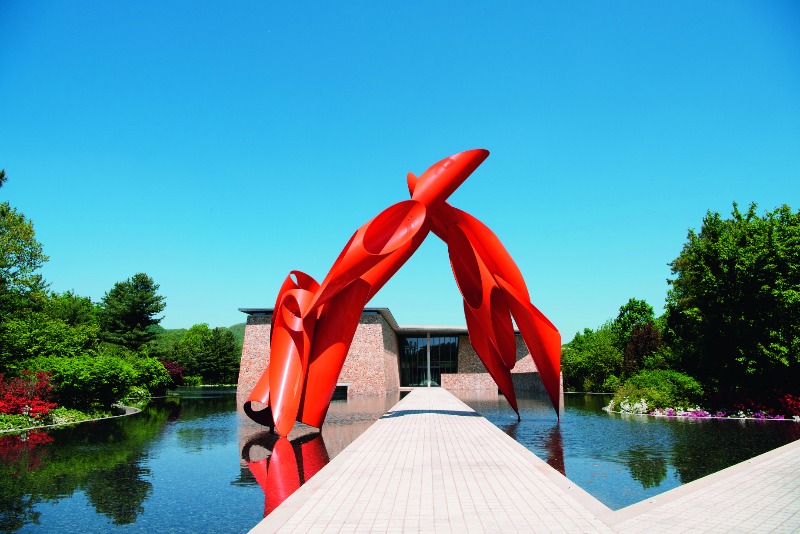
The main building of Museum SAN embodies the architect’s philosophy of linking the land, sky and people as one. The Water Garden leading visitors to the main entrance gives the impression that the museum is floating on water.
ⓒMuseum SAN